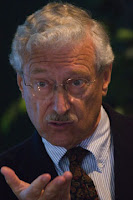Showing posts from category security.
-
Who Does Development? Civil-Military Relations (Part II)
› USAID convened a study group to determine the future civil-military relationship between USAID and the Department of Defense. Two members of the study group, Dr. Frederick Burkle, Jr., and Dr. Eugene Bonventre, offer their thoughts.
USAID convened a study group to determine the future civil-military relationship between USAID and the Department of Defense. Two members of the study group, Dr. Frederick Burkle, Jr., and Dr. Eugene Bonventre, offer their thoughts.
The success of all interventions and relief efforts in conflict and post-conflict situations is dependent on politics and political action. For the United States, political action translates into military action. During my career, I’ve been involved in five conflict situations with the U.S. military, and each one made a different claim and set different restrictions for intervening with “aid.”
In the 1990s, after several frustrating years of failures, many in government believed that humanitarian assistance without political solutions achieved nothing. In good Wilsonian fashion, they saw political action—and the military interventions that followed—as a means to project, influence, and spread U.S. values. As such, the military became the security and protection tool of political humanitarianism, especially among those who considered that the convergence of humanitarian actors with the military ensured that the duty to provide assistance and the right to receive it was guaranteed.
The Kurdish crisis after the Persian Gulf War was instrumental for many reasons. One, it was the first time the Security Council did not veto a resolution to protect vulnerable populations within a sovereign state. Two, it was considered in most circles to be a success, because the coalition led by the U.S. military was considered by the humanitarian community to have been an ally in the struggle to provide security and assistance. The military presence allowed the humanitarians to work in an austere environment and to save lives.
What happened afterwards is a different story. Influenced by the post-9/11 global war on terrorism, increasingly insecure conflict environments, and the unilateral approach to conflict management, the military began to provide direct assistance to the population themselves. Liberties were taken: NGOs were recruited as “force multipliers,” “a second front,” or “part of our combat team.” The traditional leaders of humanitarian assistance and disaster relief, the Red Cross and the UN’s Office for Coordination of Humanitarian Affairs, were ignored. A “partnership” of the U.S. military-political command, the World Bank, corporate contractors, and like-minded NGOs dominated the scene.
In the last four months I’ve been confronted by two retired generals. One strongly insisted that the military must “stay within their lane” or risk destroying the military and supporting the perception of a U.S. politico-military “empire.” The other strongly insisted that the only entity in the world that could do humanitarian assistance and disaster relief is the U.S. military
So who should be leading these efforts for the United States? USAID, which was decimated in the 1980s, has never come back. The more than 12,000 USAID professionals during the 1960s-70s now number only 2,000. Reestablishing USAID’s place in development and relief will take much money, time, and expertise.
In the meantime, the only show in town, DoD, grows even larger and stronger. Gates’ statement that more civilians are needed in Afghanistan and Pakistan was actually a request for more “civilians” to be coordinated by the military.
It is not unusual to find those who think that the politico-military “relief and reconstruction complex” is impossible to change, especially when they are favored by Congress over USAID and State to solve these problems. But if “outcome indicators” rather that the current DoD-dominated “achievement indicators” were used to measure success, they would tell a totally different story.
In the last few years, the argument that such efforts are essential to “winning the hearts and minds” of a population has come out of nowhere. This claim is not grounded in accepted measures that monitor and evaluate such success. Yet the defense budgets that are heavily supported by Congress are based on achievement indicators alone.
President Obama does not come to the table with a strong and substantive knowledge or experience with the nuances of foreign assistance and the critical importance of the traditional humanitarian community. He is currently hearing only voices from the military and industry on this issue. We owe it to both the humanitarian community and the military to ensure that evaluation of their effectiveness is transparent, accountable, and evidence-based.
Current USAID leadership, short of a named Administrator, must speak up. The opportunity to reestablish USAID’s role in development and humanitarian assistance may never come this way again.
Dr. Frederick M. Burkle, Jr., is a professor and senior fellow with the Harvard Humanitarian Initiative, Harvard University; a senior public policy scholar at the Woodrow Wilson Center; and a retired Navy Reserve Captain and combat decorated for service with the U.S. Marines. -
Lithium: Are “Blood Batteries” Next?
›July 17, 2009 // By Geoffrey D. DabelkoThe strategic minerals debate is back—but starring some new rocks. One that has received much recent attention is lithium, which is used in cell phone batteries, as well as those under development for electric cars.
Turns out lithium isn’t found in too many places. Around 50 percent of known reserves are in Bolivia, underneath some very dramatic and desolate salt flats. Worldfocus has a terrific news story that gives a glimpse of the place, the politics, and the battle over lithium extraction. Talk of an OPEC-like lithium cartel with China and Chile suggests that the politics at the international level will be just as contentious as the Bolivian domestic scene.
Our good friends over at the Center for New American Security are taking a fresh and systematic look at the strategic minerals question in their new Natural Security initiative. And we are hearing more and more about it from the advocacy community. For example, ENOUGH has ramped up its Come Clean 4 Congo campaign, which stresses the links between our cell phones, mineral extraction, and continuing violence in the Democratic Republic of the Congo. It is reminiscent of the “blood diamonds” campaigns that led to the Kimberly Process.
The lithium story and the complex social, economic, and political disputes it could engender in Bolivia should flag for us an important consideration in the fight against climate change: trying to do right by climate change and energy security might trigger unforeseen conflicts. Greening our transportation sector with more powerful batteries is going to create a new set of winners and losers around the material inputs like lithium.
We need to be much more cognizant of these impacts as we move forward in addressing climate change and the unsustainable use of fossil fuels. The Wilson Center’s Environmental Change and Security Program will be tackling this specific dimension of the climate and security debates—the potential for conflict induced by climate mitigation efforts—in the months ahead. -
VIDEO: Geoff Dabelko on the Global Environmental Change and Human Security Conference (Day Two)
›June 24, 2009 // By Wilson Center StaffThe second day of the Global Environmental Change and Human Security conference in Oslo illustrated the evolution of the environment, conflict, and security debate. The key discussion came from a panel entitled “Environmental Change, Conflicts, and Vulnerability in War-Torn Societies” that featured Ken Conca of the University of Maryland; David Jensen of the UN Environment Programme (UNEP); and Arve Ofstad of the Norwegian Agency for Development Cooperation.
In this short video, Geoff Dabelko, director of the Wilson Center’s Environmental Change and Security Program and chair of the panel, notes that in the last 10 years, researchers and practitioners have moved from a nearly exclusive focus on the connections between environmental scarcity or abundance and conflict to a wider set of questions about environment’s roles all along the conflict continuum—including prevention, active conflict, conflict termination, and post-conflict peacebuilding and reconstruction. This wider agenda includes questions of cooperation and peacebuilding around environmental interdependence. Jensen’s UNEP post-conflict office directly engages these multiple environment-conflict connections, and he shared both practical lessons learned and concrete UN points of entry.
Dabelko also comments that human security, enunciated most prominently in the 1994 UNDP Human Development Report, has raised the profile of a wider set of vulnerabilities than those coming directly from the end of a gun. This more inclusive agenda brings livelihoods, human rights, and social and cultural values more squarely into the analysis of insecurity. -
VIDEO: Simon Dalby on ‘Security and Environmental Change’
›June 23, 2009 // By Wilson Center StaffSimon Dalby, a geographer at Ottawa’s Carleton University, wants to put the “human” back into “human security” with his new book Security and Environmental Change. He is trying to find a common vocabulary to bridge the disparate languages of environmental science and security studies and enable them to mesh in a way that makes “intellectual sense.”
Dalby “argues that to understand climate change and the dislocations of global ecology, it is necessary to look back at how ecological change is tied to the expansion of the world economic system over the last few centuries. As the global urban system changes on a local and global scale, the world’s population becomes vulnerable in new ways.”
Environmental Change and Security Program Director Geoff Dabelko spoke with Dalby about his book outside the Global Environmental Change and Human Security conference in Oslo, Norway, where more than 160 experts and practitioners have gathered for three days of intense discussions. -
VIDEO: Geoff Dabelko on the Global Environmental Change and Human Security Conference
›June 23, 2009 // By Wilson Center StaffMore than 150 experts from around the world are assembled this week in Oslo, Norway, for the capstone conference of the Global Environmental Change and Human Security (GECHS) Project. The conference features a mix of researchers and policymakers, who are debating the practical impacts of bringing a focus on people more firmly into discussions of global environmental change.
The Wilson Center’s Geoff Dabelko, director of the Environmental Change and Security Program, is attending the conference, and in this video, he comments on three themes prominently discussed in the opening day of the conference: human security versus national security; climate change and migration; and practical avenues for incorporating human security research into the fifth assessment of the Intergovernmental Panel on Climate Change. -
Retired Generals, Admirals Warn of Energy’s Security Risks
›June 18, 2009 // By Rachel Weisshaar “Some, I think, probably are surprised to hear former generals and admirals talk about energy efficiency and renewable energy, but they shouldn’t be,” said General Charles Wald, USAF (Ret.), chairman of the CNA Military Advisory Board (MAB), a group of 12 retired three- and four-star admirals and generals. “Force protection isn’t just about protecting weak spots; it’s about reducing vulnerabilities before you get into harm’s way.”
“Some, I think, probably are surprised to hear former generals and admirals talk about energy efficiency and renewable energy, but they shouldn’t be,” said General Charles Wald, USAF (Ret.), chairman of the CNA Military Advisory Board (MAB), a group of 12 retired three- and four-star admirals and generals. “Force protection isn’t just about protecting weak spots; it’s about reducing vulnerabilities before you get into harm’s way.”
Wald was joined by fellow MAB member Vice Admiral Dennis McGinn, USN (Ret.), and CNA General Counsel Sherri Goodman for a discussion of MAB’s latest report, Powering America’s Defense: Energy and the Risks to National Security, at a meeting on May 28, 2009. Two years ago, Wald, Goodman, and two other members of the MAB spoke at another Environmental Change and Security Program-hosted event on the MAB’s first report, National Security and the Threat of Climate Change.
Energy, Climate, and the Military “Our over-dependence on fossil fuels” and “our dependence on a vulnerable electric grid…present an urgent and serious risk to our national security,” said Goodman, who served as deputy under secretary of defense for environmental security from 1993-2000.
“Our over-dependence on fossil fuels” and “our dependence on a vulnerable electric grid…present an urgent and serious risk to our national security,” said Goodman, who served as deputy under secretary of defense for environmental security from 1993-2000.
Powering America’s Defense argues that U.S. dependence on foreign oil “tethers America to unstable and hostile regimes, subverts foreign policy goals, and requires the U.S. to stretch its military presence across the globe.”
The U.S. military’s energy use presents unique risks. “Our inefficient use of oil adds to the already-great risk assumed by our troops. It reduced combat effectiveness. It puts our troops more directly and more often in harm’s way,” said Wald. “Many of our casualties—and you’ve all heard of the IEDs and EIDs that have done so much harm to so many of our young people—many of those people are in convoys carrying fuel to the battlefield” in Iraq and Afghanistan.
A major U.S. blackout in August 2003—which shut down water and sewage plants, gas stations, telecommunications outlets, and some elements of border check systems—emphasized the vulnerability of the nation’s electrical grid. “The situation can be exploited as a threat by those to wish to do us harm,” said Wald.
Innovative Solutions, With DoD in the Lead
The report recommends that:- Energy-security and climate-change goals should be integrated into national-security and military planning processes;
- The Department of Defense (DoD) should design and deploy energy-efficient systems on the battlefield;
- DoD should monitor its energy use at all levels of operations;
- DoD should improve the energy efficiency of its installations;
- DoD should increase renewable-energy generating capacity; and
- DoD should invest in the development of low-carbon liquid fuels—such as those produced by algae—that can replace oil.
A Direct Appeal
Recalling the sacrifices Americans made on the home front during World War II—saving scrap metal, conserving fuel, planting victory gardens—McGinn urged Americans today to take a similar approach to meeting the nation’s energy and climate challenges.
“There are individual steps that every American can take: using less energy, being more efficient with the energy that we do use, supporting new policies to help our country take a new energy path,” he said. “They may cost money, yes, but if we don’t spend the money now, primarily thinking of that as an investment, we’ll still pay, and we’ll pay much more later. In fact, very likely, we’ll pay in American lives lost,” he said. -
At Heavy-Hitting Conference, CNAS Launches Natural Security Program, Blog
›June 11, 2009 // By Rachel WeisshaarToday’s Center for a New American Security (CNAS) annual conference was replete with heavy hitters like General David Petraeus discussing the world’s top security challenges, including Iraq, Afghanistan, Pakistan, and North Korea. But at an afternoon panel, CNAS’s Sharon Burke argued that although environmental and natural-resource issues may not get their own section in the Presidential Daily Briefing, they are intimately intertwined with many of the high-profile security issues that do.
President Obama recently called for a stronger focus on agricultural development in Afghanistan, said Burke, as part of a broader approach to increasing stability and improving Afghans’ quality of life. But decades of war have contributed to severe deforestation and land degradation, and farmers “can’t plant their seeds if the land is barren, and that’s where we are right now,” she said.
The panel also served as the launch for CNAS’s new Natural Security program (see working paper) and blog, which aim to study the “national-security implications of natural resources use,” said Burke. The program grows out of CNAS’s investigation of the security impacts of climate change and energy over the past several years. Burke explained that it was difficult to discuss energy and climate change without also talking about water, land, biodiversity, and a host of other related issues, so CNAS decided to create a program that would not attempt to separate these interconnected issues.
Burke was joined by former U.S. Senator John Warner, Peter Gleick of the Pacific Institute, Roderick Eggert of the Colorado School of Mines, and Commander E. J. McClure of the Office of the Secretary of Defense. -
The Indian Ocean: Nexus of Environment, Energy, Trade, and Security
›June 5, 2009 // By Brian Klein “[F]or global trade, global food security, and global energy security, the Indian Ocean is critical,” says Amit Pandya in The Indian Ocean: Resource and Governance Challenges, the most recent addition to the Stimson Center’s Regional Voices: Transnational Challenges report series. “And it remains a stage for the pursuit of the global strategic and regional military interests of all world and regional powers.”
“[F]or global trade, global food security, and global energy security, the Indian Ocean is critical,” says Amit Pandya in The Indian Ocean: Resource and Governance Challenges, the most recent addition to the Stimson Center’s Regional Voices: Transnational Challenges report series. “And it remains a stage for the pursuit of the global strategic and regional military interests of all world and regional powers.”
During a launch event on May 21, Pandya—the project director behind the series—sat with Stimson Director Ellen Laipson, Vice Admiral Kevin Cosgriff, USN (Ret.), and East-West Center in Washington Director Satu Limaye to reflect on the report and discuss the myriad challenges facing Indian Ocean states in the maritime resources and governance sectors.
The 21st Century’s “Center Stage”
The Indian Ocean’s international profile has been bolstered by the region’s rising economic prowess and political clout, significant resource wealth, and critical shipping routes—which transport the vast majority of oil leaving the Persian Gulf. Journalist Robert Kaplan recently labeled the region “center stage for the 21st century” because of its importance to global trade and energy, as well as the fact that it hosts the “dynamic great-power rivalry” between India and China.
The Stimson report is divided into two sections: the first comprises several articles written by authors from Indian Ocean littoral states, while the second includes pieces from Pandya and Laipson that analyze and interpret general trends in regional ocean governance.
Ocean Resources, Maritime Security
“In the last half-century, the production of fish and fish products in the Indian Ocean (IO) region has increased tremendously as a result of improvements in fish capture technology and rising demand caused by a growing global population,” write Edward N. Kimani et al. in their article in the report, which examines southwest Indian Ocean fisheries. These trends have precipitated conflict between small-scale artisanal fishers and industrial fishers, in addition to placing enormous pressure on ocean ecosystems. Effective management mechanisms must be implemented in order to address overfishing and its consequences for global food security and ecosystems. (A forthcoming documentary, The End of the Line, takes an in-depth look at overfishing.)
In a similar vein, Mak Joon Num’s contribution, “Pirates, Barter Traders, and Fishers: Whose Rights, Whose Security?”—roundly praised by speakers at the report launch—considers the diverse range of stakeholders operating in the Straits of Malacca and the Sulu Sea. Malaysian trawler fishers, Acehnese pirates, and Filipino barter traders compete to glean their livelihoods from the ocean. All are victims and predators in their own right, Mak Joon Num argues, and climate change, poverty, and a lack of coordinated ocean governance policies exacerbate the present problems of resource scarcity, disputed sovereignty, and unsustainability.
Shifting to the northwestern littoral states of the Indian Ocean, Mustafa Alani presses the case for a comprehensive maritime security compact in the Persian Gulf, which holds more than 30 percent of the world’s known oil deposits. The Gulf Cooperation Council provides the foundational structure for such an agreement, which would likely comprise several levels of cooperation, ranging from “soft security”—managing fishing and environmental degradation, search-and-rescue coordination, and marine transport—to “strategic security”—coordinating naval exercises and anti-terrorism operations.
Questions of Governance
In order to address these challenges, concerned states must put forth “more effort at the national level to integrate civilian and military aspects of maritime policy,” Laipson concludes in the report’s final lines. “We also need a fresh look at the regional and international levels to ensure that governance of the maritime realm strives to manage the complex interplay of human and natural activity and to maintain the Indian Ocean as a sustainable zone for commerce, energy, security, and peace.”
Population: A Missing Factor?
While the report does an excellent job of illuminating the resource and governance challenges in the Indian Ocean, it fails to substantively consider one factor that will have a profound influence on all others: population growth. Burgeoning populations in Indian Ocean states will have considerable consequences for resource management, governance, poverty, and security in the region, particularly in relation to migration, human trafficking, overfishing, and ecosystem health.
Photo: Artisanal fishers off the Malabar coast of India. Courtesy Flickr user mckaysavage.


 USAID convened
USAID convened  “Some, I think, probably are surprised to hear former generals and admirals talk about energy efficiency and renewable energy, but they shouldn’t be,” said General Charles Wald, USAF (Ret.), chairman of the CNA
“Some, I think, probably are surprised to hear former generals and admirals talk about energy efficiency and renewable energy, but they shouldn’t be,” said General Charles Wald, USAF (Ret.), chairman of the CNA  “Our over-dependence on fossil fuels” and “our dependence on a vulnerable electric grid…present an urgent and serious risk to our national security,” said Goodman, who served as deputy under secretary of defense for environmental security from 1993-2000.
“Our over-dependence on fossil fuels” and “our dependence on a vulnerable electric grid…present an urgent and serious risk to our national security,” said Goodman, who served as deputy under secretary of defense for environmental security from 1993-2000.
 “[F]or global trade, global food security, and global energy security, the Indian Ocean is critical,” says Amit Pandya in
“[F]or global trade, global food security, and global energy security, the Indian Ocean is critical,” says Amit Pandya in 

